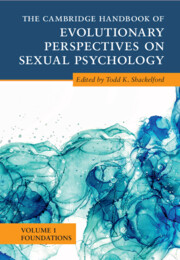Book contents
- The Cambridge Handbook of Evolutionary Perspectives on Sexual Psychology
- The Cambridge Handbook of Evolutionary Perspectives on Sexual Psychology
- Copyright page
- Contents
- Contributors
- Preface
- Part I Foundations of Evolution
- Part II Middle-Level Theories
- 7 Parental Investment Theory
- 8 Parent–Offspring Conflict
- 9 Theory and Evidence for Reciprocal Altruism
- 10 Life History Theory and Mating Strategies
- 11 Sperm Competition Theory
- 12 Sexual Conflict Theory
- 13 Cross-Species Comparisons
- 14 Cross-Cultural Methods in Sexual Psychology
- 15 Behavioral Genetics
- 16 Sex Differences and Sex Similarities
- 17 Individual Differences in Sexual Psychology
- 18 Experimental Methods in Sexual Psychology
- Index
- References
14 - Cross-Cultural Methods in Sexual Psychology
from Part II - Middle-Level Theories
Published online by Cambridge University Press: 30 June 2022
- The Cambridge Handbook of Evolutionary Perspectives on Sexual Psychology
- The Cambridge Handbook of Evolutionary Perspectives on Sexual Psychology
- Copyright page
- Contents
- Contributors
- Preface
- Part I Foundations of Evolution
- Part II Middle-Level Theories
- 7 Parental Investment Theory
- 8 Parent–Offspring Conflict
- 9 Theory and Evidence for Reciprocal Altruism
- 10 Life History Theory and Mating Strategies
- 11 Sperm Competition Theory
- 12 Sexual Conflict Theory
- 13 Cross-Species Comparisons
- 14 Cross-Cultural Methods in Sexual Psychology
- 15 Behavioral Genetics
- 16 Sex Differences and Sex Similarities
- 17 Individual Differences in Sexual Psychology
- 18 Experimental Methods in Sexual Psychology
- Index
- References
Summary
Cross-cultural research methods are widely used in evolutionary sexual psychology research. These methods are applied to reveal both human universals and culture-specific patterns. In this chapter I discuss the benefits and limitations of various methods, including surveys with forced-choice and free-choice response scales, ratings based on the Standard Cross-Cultural Sample, and the use of pictorial, video, and audio stimuli. Methodological problems, ranging from the conceptual and operational definitions of a particular trait in each culture or country to investigating and establishing equivalency of scales and ratings across cultures or countries are presented. Evolutionary perspectives have addressed love, long-term partner choice, marital satisfaction, jealousy, and attractiveness in cross-cultural studies. Special attention has been given to the problems of validation of instruments in WEIRD and non-WEIRD societies, both large-scale and small-scale societies. For illustrative purposes, I review Sternberg’s Triangular Love Scale and summarize recent cross-cultural research conducted in Western and non-Western, modern and traditional societies. The Marriage and Relationships Questionnaire and the Ideal Mate Preferences Scale have been used in cross-cultural work, and the benefits and limitations of these instruments for evolutionary sexual psychology are reviewed. Universal sex differences in ideal mate preferences obtained in cross-cultural survey research have been illustrated by various statistical procedures. The use and utility of stimuli methods in cross-cultural research, especially in the case of non-WEIRD, small-scale societies, has been demonstrated. Substitution of real body images by silhouettes may help to avoid unnecessary discomfort of respondents related to variations in cultural norms of body presentation. I discuss adjustments of stimuli images developed for Western cultures for use in non-Western cultures. Examples of such adjustments of stimuli images are provided (e.g., body color of silhouettes are adjusted to more closely match the local population). I conclude that effective cross-cultural methods today are variable and not limited to questionnaires and interviews. Many such methods are appropriate for evolutionary studies of sexual selection, to reveal universal sex differences in sexual strategies, particularly those related to reproductive success, partner choice, and parental uncertainty.
Keywords
- Type
- Chapter
- Information
- Publisher: Cambridge University PressPrint publication year: 2022

